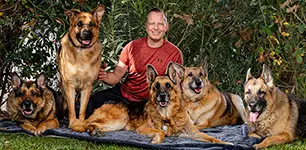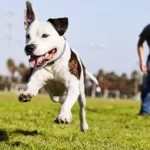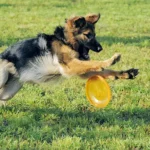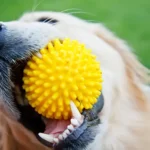
Play-based dog training is the most effective form of dog training because it speaks to the fundamental nature of dogs. Canines refine their innate hunting skills through rough-and-tumble play with their littermates.
As Stuart Brown outlined in his 2009 TED Talk “Play is more than Fun,” Play is essential to cognitive, emotional, and physical development. As such, true Play doesn’t have a purpose more important than playing itself.
Neurologist Frank Wilson (author of The Hand) also points out that Play—especially Object Play early in life—enhances problem-solving abilities. Moreover, Play is part of exploration and learning. This is no different for humans than other mammals, including dogs. Play is vital. Furthermore, Play is not just a rehearsal for life, as we previously believed. Play is more. Above all, Play serves an important biological function, like sleeping and dreaming. In addition, Play Deprivation has been observed as a major contributor to anti-social and even criminal behaviors.
Play Patterns
The National Institute for Play distinguishes the following Play Patterns:
Attunement Play: When a mother and her infant make eye contact, each experiences joy. This is personal, emotional play. Read more on Attunement Play.
Body and Movement Play: Body movement fosters learning. Innovation, flexibility, adaptability, and resilience are rooted in movement. Read more on Body and Movement Play
Object Play: Curiosity about and playing with objects/toys is fun. Skills of manipulating objects develop through playing with toys and generally using our hands (or paws) to help build richer brain circuits. Subsequently, effective adult problem-solving skills develop from manipulative skills acquired at an early age.
Imaginative Play: The ability to create our own sense of our mind is key to innovation and creativity. The earliest evidence of imaginative play comes at about the age of two, through fragmentary stories.
Social Play: A key aspect of Play behavior. Learning to belong is developed in Social Play. From the simplest game of peek-a-boo to the most formal dinner party, social play is a prominent type of human play behavior.
Rough and Tumble Play: Rough-and-tumble play is generally defined as friendly fighting or play fighting and extends to any active play that includes shouting or body contact among children. It helps develop social regulation and cognitive, emotional, and physical development. Depriving youngsters of rough-and-tumble play hampers their ability to learn the normal give-and-take necessary for social mastery and has been linked to poor control of violent impulses in later life. Read more on Rough and Tumble Play
Celebratory and Ritual Play: Children don’t need formal events to practice celebratory or ritual play; they do so naturally as part of their social play. Ritual play is a more adult-oriented type of play. For children, celebratory or ritual play may involve a birthday celebration, a holiday dinner, or a religious observance. Some dogs enjoy celebrating as part of their play patterns. It usually involves carrying their toy (caught prey) in their mouths.
Storytelling and Narrative Play: Stories help us to understand ourselves and others. Storytelling occupies a central place in early development and learning about the world, oneself, and one’s place in it. Our minds continually make up stories about why things are the way they are, and those stories form our understanding of the world. Stories are a way of putting disparate pieces of information into a unified context.
Some of these patterns apply more to humans than any other species, but essentially, Play helps brain development, social regulation, and is fun—those elements are universal. However, the opposite of play is not work; it’s depression.
The Joy of Play
Dogs love to play! Some dogs prefer playing with toys and will enjoy some toys more than others. Some dogs enjoy playing with food, and some dogs enjoy personal play. Just like with humans, Play is an essential part of canine development. Dogs that play and socialize regularly are healthier, more balanced, curious, calmer, less reactive, and just a lot more fun to live with.
If you want the best relationship you can have with your dog and your friend to be happy, make sure your furry family member gets to play with you, with other dogs, and with toys. This also extends to training. Play-based dog training is the most effective way of training.
Play is fun, helps learning, and supports mental health.
For this reason, play-based training is the most enjoyable for your dog and leads to the fastest training results while also improving your relationship. If learning doesn’t feel like work, you want to do more and learn faster, which is no different for your dog.
The Best Way to Play
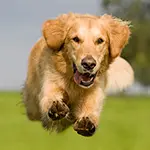
The best way to play with your dog is to play in a way your dog enjoys. You may want to throw a ball and have your dog bring it back to you, but if your dog doesn’t enjoy that sequence as much as you do, he won’t be enthusiastic about it and will quit early. It’s only fun for your dog if he gets to play the way he enjoys it. Some dogs love the throw-ball-fetch-and-throw-again game; for those dogs, that is the best game in the world. But if your dog doesn’t want to bring the ball back or ends up sitting away from you after retrieving it to chew on, he is more interested in a different game. Effective play-based training involves figuring out what game YOUR dog enjoys the most.
Understanding Play
The aspects of play dogs enjoy are all part of the predatory hunting sequence: Searching—Stalking—Chasing—Fighting—Celebrating—Consuming. If you want to dive deeply into this, I recommend the lecture Tug: A Deeper Perspective by Jay Jack from Next Level Dogs.
Not all dogs enjoy all play aspects equally, but these are the six key elements. The other differentiator is the kind of player your dog is: supportive or competitive.
A supportive player wants to play WITH you. A dog that brings the ball back after you throw it is such a player.
A competitive player wants to play AGAINST you. Such a dog enjoys conflict in Play and may keep the ball from you as he wants you to chase him. Voracious tug-of-war players are another example.
Of course, you can train fetch-and-retrieve to a dog that prefers playing different games, but then it’s no longer play; it’s work. It may be how you want to play, but you have two options if your dog doesn’t. You can either spend the time to train your dog to play the game you want, but that may no longer be fun for you (and now you know how your dog feels about that game), or play with your dog the way he enjoys. I recommend the latter.
Observe your dog when playing. Throw a ball, and see what he does. Try playing tug, and see what happens. Watch him play with other dogs or on his own. Pay attention to what you see.
The Aspects of Play
Searching: Does your dog explore? Run under bushes? Is he curious about things? He may enjoy searching. Play hide-and-seek games with him. Hide treats for him to find. Or get him involved in a tracking club. Or scent work.
Stalking: Does your dog freeze in place to stare down smaller animals before chasing them? He is stalking. Good hunters know how to stalk well. If your dog likes this, make him wait for toys or treats. If he moves towards them, pull them back and try again. Encourage him to stalk the toy or treat. He only gets it if he patiently waits for the toy/treat to come to him.
Chasing: Does your dog enjoy chasing after toys, other dogs, or food you throw? Does your dog try to catch squirrels, rabbits, birds, etc.? Your dog enjoys chasing. Most dogs enjoy chasing. Throw balls or other toys for your dog to chase after.
Fighting: Does your dog enjoy solving problems or dog puzzles, overcoming obstacles, or shows interest in getting into something? Those are all fighting activities. Overcoming obstacles or resistance is fighting; don’t just think of it in terms of physical altercations. Obviously, we don’t want physical fights with other animals or people. So, surrogate activities that include overcoming resistance are great alternatives your dog will enjoy.
Celebrating: Does your dog have a swagger in his gait after getting a ball and bringing it back? Does he like carrying things around in his mouth after he gets them? Your dog is celebrating. Make sure you always let him hold on to things for a bit after he retrieves something for you. Always allow for celebration before asking for the ball or toy back. Too many people deprive their dogs of their celebrations.
Consuming: Does your dog chew a lot? Does he keep toys, lie down somewhere and chew on them instead of bringing them back to you? Does your dog love to work for treats? Your dog likes consuming. Let him consume. Offer food to get toys back. Add food to toy play routines at the end of a play round.
Conclusion
Once you understand how your dog likes to play, design games he will enjoy. You can include all these play aspects when playing with food, toys, or even personal play. You can also combine different play types. For example. you could play tug with a tug toy (or rope or a large bully stick), and for consumption, offer high-value treats.
Let your dog tell you what he enjoys and play accordingly.
By figuring out what kind of player your dog is and what aspects of play he enjoys, you can create and play the most fun games with your dog. It will take your relationship to a new level. And if you need help designing the perfect games for you and your dog, call us. We offer in-person and virtual sessions for game design.
Once you have learned how to play how your dog likes it, you have also unlocked the key to the most effective way to train your dog and are ready for play-based dog training. The game you just developed can now become the reward for any skills you may want to teach your dog. Sit – Down – Stay – PLAY!
Play is the way!
Play the Audio


